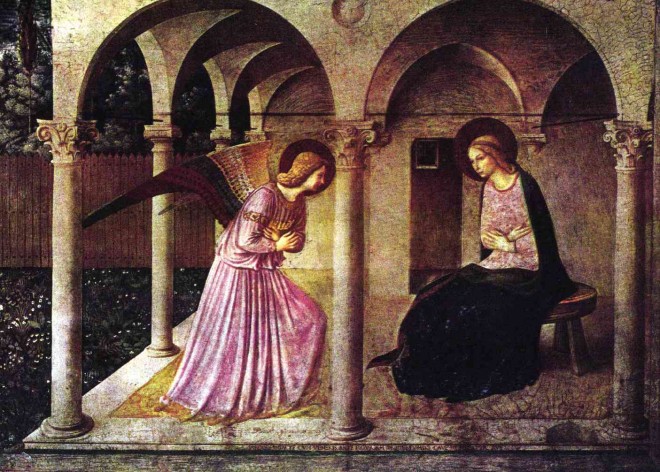
“…Fear not, Mary; for thou hast found favor with God. And, behold, thou shalt conceive in the womb, and bring forth a son, and shalt call his name Jesus…” (Lk 1: 28-38)
Thus announced the angel Gabriel to Mary on the day which, according to the present Gregorian calendar, falls on March 25. This date, exactly nine months before Dec. 25, is meaningful to Catholics and other Christians worldwide.
The date of the annunciation may be contentious by reason of the fact that the present Gregorian calendar (after Pope Gregory XIII), which corrected the errors of the previous Julian calendar, was adopted by the predominantly Catholic nations of Europe when it was released in October 1582. The fact of the annunciation overpowers the date in significance, for the glorious event already recognized the presence of God. The angel Gabriel said: “I am Gabriel that stand in the presence of God” (Lk 1: 9).
Western artists’ depictions of the annunciation show the glorious event not on the geographic truthfulness of the location, but on the artists’ tangential interpretations of the place where the annunciation took place. And worse, the artists infused trends and some material identities of their places, like Sienna, which is miles away from Nazareth where Christ’s birth was announced.
Simone Martini, a Siennese painter, rendered “The Annunciation” in 1333. In “A Treasury of Art Masterpieces,” edited by Thomas Craven, is this entry: “… Martini… considered, first, the placement of the figures, the linear pattern, the effect of color against a background of gold, and the appeal of the altarpiece as a splendid object of art. He gave subordinate consideration to the subject matter and its emotional implications. As a consequence, the painting invites aesthetic appreciation but does not deeply disturb the emotions. But the painting, as a design, is the flower of medieval decoration and one of the permanent glories of Siennese art…”
In short, this so-called masterpiece of Western religious art is hopelessly tangential to the religious message that transcends geography, race and time. The angel Gabriel casts his eyes downcast, and not straight in the eye of the Virgin Mary, which could have underscored the impact of the annunciation. Neither does the Virgin Mary look at the message-bearer in the eye. The annunciation impacts on neither. The initial incredulity of Virgin Mary is lost in her body that, in fact, is an act of resistance.
The so-called critique is fixated on visuals, reducing the annunciation, both as a glorious event and as a painting, to the level of craft. Nobody in his right mind gives a hoot if the painting “is the flower of medieval decoration and one of the permanent glories of Siennese art…” Any painting, regardless of subject, transcends its locus and becomes a universal depiction of such a subject which impacts on the image of man and society.
Of the six other figures, only the figures on the left top and the third from the left, both of whom are in red robes, look down to the center where a flower vase (the flowers have thorned stems yet!), stands. Alienation to the glorious event is as clear as the gold background showing pointed Gothic arches with 17th-century Baroque curlicues.
Such color may be incongruous to the humility and simplicity in the life and house of St. Joachim and St. Anne, parents of the Virgin Mary. Incorporating one’s national and cultural identity to a purely religious subject, as Martini did, comes not only as a mental lapse, but a form of sacrilege. Or both.
A century and 12 years later, Fra Angelico, a Dominican monk, painted his version of the annunciation. In the same book cited above, this entry appears: “…the Virgin is seated in an open loggia resembling that of a Florentine church, with the angel Gabriel alighting before her. The fresco… shows Fra Angelico’s fully developed style in wall decoration…”
Not unlike the previous critique, this one mercilessly rammed down the painting to the level of simply a “wall decoration.” Nothing is said about the glorious event.
While St. Luke is silent on what the place looked like, it could not have looked like the “loggia of a Florentine church,” no matter how far the imagination is stretched.
The angel Gabriel and the Virgin Mary, following a left-to-right reading of the painting, are separated by a column with Corinthian capital, which is itself part of six visible columns with a hullabaloo of different capitals. The central Corinthian column is unnerving due to the clear alienation of the message carrier and the message receiver from one another. The mix-up of quasi-Greek columns supporting a massive building with rounded Roman arches is an irrational exercise of eclecticism.
The right hand of the angel Gabriel could have been raised as a triumphal gesture to the glorious event that impends. This is sublimated, somehow, by the right hand over the left, to show that righteousness overpowers “lefteousness.” The right and left fingers are effeminate, with the latter being anatomically deficient.
The left hand of the Virgin Mary is over the right. The ideatic blur clouded Angelico’s mind. Result: the painter’s depiction is a terrible miscue on the glorious event.
Truthfulness
Truthfulness is a must in any artwork depicting a religious event. A trip from Italy to Israel, specifically in the city of Nazareth, could have given the painting a semblance of the place where the annunciation took place.
Granted that impediments intervened, the Bible was surely in Angelico’s hands, even before he, as Guido di Pietro da Mugello, entered the Dominican order at age 20.
Martini could have made the trip likewise. And yet, these two paintings, which are in Florence, are hailed as “masterpieces” in Western religious art.
Sorry, but no Amen to that.

